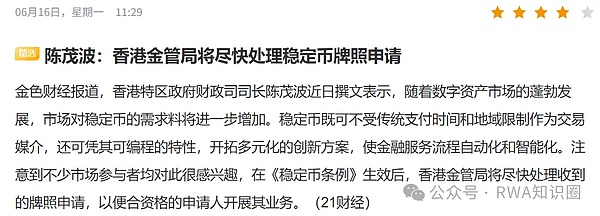1. Corporate compliance window under the regulatory divide between the United States and Hong Kong
The recent vote of the U.S. Senate on the GENIUS Act has become a watershed event for corporate payment strategies. According to The Block, after weeks of negotiation, the final version of the bill has undergone a major turn: new clauses explicitly prohibit non-financial listed companies such as Meta and Amazon from issuing stablecoins unless they pass strict financial risk and data privacy reviews. This sudden change caught many businesses off guard, especially Walmart and Amazon, which were just exposed in June to be preparing their own stablecoins.

2. Stablecoins reconstruct the path of payment costs for retail enterprises
The current "stablecoin dilemma" of retail enterprises stems from the differences between the U.S. Senate and the House of Representatives-After the bill was rejected in May, the Senate version added three key constraints:
Restrictions on issuing entities:Non-financial enterprises are prohibited from issuing stablecoins
Asset anchoring requirements:Must be 100% backed by US dollars or equivalent liquid assets
Audit red line:Issuers with a market value of more than US$50 billion must undergo annual audits
Strict requirements have deterred many companies that intend to issue stablecoins in the United States,and the implementation of the bill has directly translated into quantifiable financial losses.Take retail giants Walmart and Amazon as examples: their credit card payment costs account for about 2% of their transaction volume. If they use stablecoins for payment (the cost can be reduced to less than 0.3%), based on the sales of US$700 billion each in 2025,more than US$28 billion in cost optimization space will be lost each year.
3. The Breakthrough Value of Hong Kong Window
When the United States raised the entry threshold, Hong Kong established an innovation-friendly regulatory framework through the Stablecoin Ordinance, which provided new possibilities for small and medium-sized enterprises that were trapped by the strict regulation of the United States. For the majority of small and medium-sized enterprises, the high cost and long cycle of cross-border payments have always been an unbearable pain point - the cost of traditional cross-border payments is generally as high as 6%, and the cycle is as long as 3-7 days. This is a heavy burden for small and medium-sized enterprises with limited profit margins, and may even swallow up most of the profits of cross-border trade.
And Hong Kong's regulatory framework provides a compliant path to solve these pain points. Large retail companies such as JD.com have already carried out relevant practices under the regulatory system of Hong Kong. The stablecoins they launched are based on the public chain and are pegged 1:1 with legal currencies such as the Hong Kong dollar or the US dollar. They have now entered the second phase of sandbox testing. According to its test results, the payment cost has been reduced from 6% to 0.0001%, and the cycle has been compressed from 3-7 days to seconds. If such solutions are implemented in cross-border payment, retail payment and other scenarios in the future, for companies with a trade volume of hundreds of billions of dollars, the annual loss reduction may exceed 6 billion US dollars. The cost and efficiency optimization space demonstrated by this practice is also expected by many small and medium-sized enterprises.

The subtlety of the Hong Kong Stablecoin Ordinance lies in: focusing on the essence of payment tools, clarifying four types of "regulated activities (issuing stablecoins in Hong Kong/issuing stablecoins anchored to Hong Kong dollars overseas/government announcement activities/related promotional activities) through Article 5, and at the same time, Part 2 of the Ordinance strictly prohibits the packaging of stablecoins as investment products for market promotion. This regulatory logic incorporates the entire chain of issuers, platform providers, and wallet service providers into the system, and reserves a compliance channel for non-financial enterprises. While this institutional design reserves channels for non-financial enterprises, it also puts forward higher requirements for continuous compliance capabilities.
Fourth, continuous compliance requirements for licensed companies in Hong Kong
Capital reserves: Pay liquid assets equivalent to not less than HK$25 million
Continuous expenditure: Fixed annual fee of HK$113,020 (first installment to be paid within 14 days)
Liquidity guarantee: Provide unconditional free redemption rights (Article 27 of the Ordinance)
The financial barriers formed by these requirements have "dissuaded" most small and medium-sized enterprises from participating in stablecoin projects, but this does not mean that small and medium-sized enterprises are in a desperate situation in the stablecoin track.
V. Breakthrough path under global competition
Technology empowerment: Develop smart contract systems that meet regulatory requirements for licensed institutions;
Resource docking: Link stablecoin issuers, reserve asset custodians and application scenario parties through compliant intermediaries to form a collaborative network;
Scenario integration: Embed stablecoin payment modules into e-commerce platforms.
Faced with the complex environment brought about by the regulatory differentiation between the United States and Hong Kong, systematically improving compliance awareness and practical capabilities has become the key for enterprises to break through. To this end, professional courses focusing on the field of real asset tokenization (RWA) will be launched soon. The courses will cover three core modules: comparative analysis of the regulatory frameworks of the United States and Hong Kong, design of compliance participation paths for non-licensed enterprises (including practical application scenarios of stablecoins), and full-process guidelines for cross-border business implementation, helping enterprises build sustainable ecological participation strategies in the era of regulatory differentiation.
 JinseFinance
JinseFinance
 JinseFinance
JinseFinance JinseFinance
JinseFinance JinseFinance
JinseFinance JinseFinance
JinseFinance Zoey
Zoey Coindesk
Coindesk Others
Others Cointelegraph
Cointelegraph 链向资讯
链向资讯 Cointelegraph
Cointelegraph